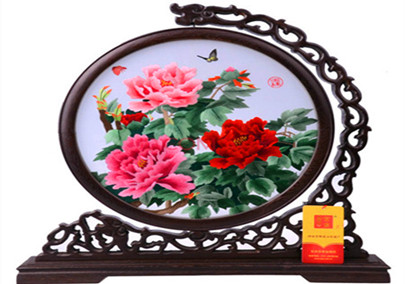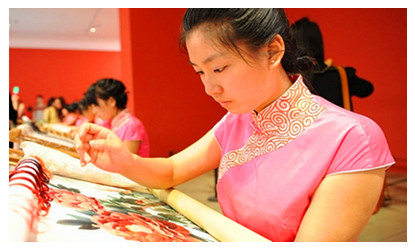
Xiang Embroidery
 Chinese embroidery boasts a long history of several thousand years. Xiang Xiu, or Hunan embroidery, is one of the four major styles. It features light and shading that give the picture a three-dimensional effect.
Chinese embroidery boasts a long history of several thousand years. Xiang Xiu, or Hunan embroidery, is one of the four major styles. It features light and shading that give the picture a three-dimensional effect.Hunan embroidery, known as Xiang Embroidery, is one of the Four Great Embroideries in China (the four categories are embroidery respectively of Suzhou, Sichuan, Guangdong and Hunan). And it is world famous for its exquisite technics, unique features and long history. Archeologists have discovered finely embroidered silk items in Changsha Mawangdui Han Toms (206BC-220AD), indicating that more than 2,000 years ago Hunan embroidery craftwork had emerged.
During the long process of development, Hunan embroidery adopted the techniques used in traditional Chinese painting and formed its own unique style. By the end of the Qing Dynasty (the early 20th century), the technics of Hunan embroidery reached its peak and even took the leading position, surpassing Su embroidery.
 Hunan embroidery is famous for its tiger patterns. The unique techniques of the Hunan embroidery are generally based on Chinese painting, although it also includes the techniques of engraving,calligraphy, and embroidery. The combination of these techniques produced a new and unique embroidery product, double-faced and with different images and colors on each side of a transparent chiffon, greatly uplifting the artistic value of Hunan embroidery. The main threads used include pure silk, satin,transparent gauze and nylon, etc.
Hunan embroidery is famous for its tiger patterns. The unique techniques of the Hunan embroidery are generally based on Chinese painting, although it also includes the techniques of engraving,calligraphy, and embroidery. The combination of these techniques produced a new and unique embroidery product, double-faced and with different images and colors on each side of a transparent chiffon, greatly uplifting the artistic value of Hunan embroidery. The main threads used include pure silk, satin,transparent gauze and nylon, etc.
Hunan embroidery is not only highly value dartistic crafts, but also slinky and practical commodities. It has won many awards at several international expositions held in Japan, Panama and the US,enjoying high reputation in the international market.
Xiang embroidery is made from silk, hard satin, soft satin, transparent gauze and colorful silk and yarn. It features rigorous composition, bright colors and expressive needle techniques. Through rich colorful lines and changing needle techniques, the characters, animals, landscapes and flowers and birds are all bestowed with a special artistic effect. Seen from the embroidery product unearthed from a Chu tomb in 1958, embroidery already gained some development in Hunan in the Spring and Autumn Period as early as over 2500 years ago.
In recent years, with the development of the Xiang embroidery production, and through diligent work of the embroidery workers and the improvement in the Xiang embroidery technique by some excellent painters, many fine traditions of Chinese painting have been transplanted to embroidery products and skillfully combined with Chinese traditional painting, embroidery, poetry, calligraphy and stone art, hence forming Xiang Embroidery that is based on Chinese painting and applies more than 70 needle techniques and lines of over 100 colors to bring the expression of the needle technique to full play as well as to depict the appearance and internal features of an object in fine detail. Xiang Embroidery has won a reputation as “flower embroidered creates fragrance, birds embroidered can be heard, tiger embroidered can run and man embroidered can be lifelike.”







 Ask Questions ?
Ask Questions ?